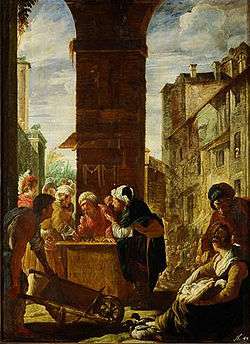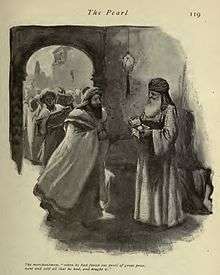Parable of the Pearl

The Parable of the Pearl (also called the Pearl of Great Price) is one of the parables of Jesus. It appears in Matthew 13:45-46 and illustrates the great value of the Kingdom of Heaven.
It immediately follows the Parable of the Hidden Treasure, which has a similar theme and the parable has been depicted by artists such as Domenico Fetti. A version of this parable also appears in the non canonical Gospel of Thomas 76.[1]
It is as follows:
Again, the kingdom of heaven is like unto a merchant man, seeking goodly pearls: Who, when he had found one pearl of great price, went and sold all that he had, and bought it.— Matthew 13:45-46, King James Version
Interpretation

This parable is generally interpreted as illustrating the great value of the Kingdom of Heaven (pearls at that time had a greater value than they do today[2]), and thus has a similar theme to the Parable of the Hidden Treasure. John Nolland comments that it shares the notions of "good fortune and demanding action in attaining the kingdom of heaven"[2] with that parable, but adds the notion of "diligent seeking."[2]
The valuable pearl is the "deal of a lifetime"[2] for the merchant in the story. However, those who do not believe in the kingdom of heaven enough to stake their whole future on it are unworthy of the kingdom.[3]
This interpretation of the parable is the inspiration for a number of hymns, including the Swedish hymn Den Kostliga Pärlan (O That Pearl of Great Price!), which begins:
O that Pearl of great price! have you found it?
Is the Savior supreme in your love?
O consider it well, ere you answer,
As you hope for a welcome above.
Have you given up all for this Treasure?
Have you counted past gains as but loss?
Has your trust in yourself and your merits
Come to naught before Christ and His cross?[1]
- ^ O That Pearl of Great Price!, The Cyber Hymnal.
A less common interpretation of the parable is that the merchant represents Jesus, and the pearl represents the Christian Church.[4] This interpretation would give the parable a similar theme to that of the Parable of the Lost Sheep, the Lost Coin, and the Prodigal Son.
The phrase "Pearl of Great Price" has also been interpreted more widely to apply to things of great value in a number of religious contexts. For example, it is the title of a selection of Mormon writings. Pope Pius XII used the phrase to describe virginity.[5]
The pearl itself is a beautiful, single entity, formed through suffering in the heart of the oyster (in the same way that believers endure lack of wealth or comfort) and like the Church, will be put on display in a coming day. Unlike precious stones which must be cut and polished to reveal their clarity and beauty, the pearl is perfect as it comes from the oyster.[6]

Gospel of Thomas
A version of the parable also appears in the Gnostic Gospel of Thomas (Saying 76):[1]
Jesus said, "The Father's kingdom is like a merchant who had a supply of merchandise and found a pearl. That merchant was prudent; he sold the merchandise and bought the single pearl for himself.So also with you, seek his treasure that is unfailing, that is enduring, where no moth comes to eat and no worm destroys."
— Gospel of Thomas 76, Patterson/Meyer translation
This work's version of the parable of the Hidden Treasure appears later (Saying 109), rather than immediately preceding, as in Matthew.[7] However, the mention of a treasure in Saying 76 may reflect a source for the Gospel of Thomas in which the parables were adjacent,[7] so that the original pair of parables has been "broken apart, placed in separate contexts, and expanded in a manner characteristic of folklore."[7] In Gnostic thought the pearl may represent Christ or the true self.[7] In the Gnostic Acts of Peter and the Twelve, found with the Gospel of Thomas in the Nag Hammadi library, the travelling pearl merchant Lithargoel is eventually revealed to be Jesus.[8]
Depictions
There have been several depictions of the New Testament parable in art, including works by Domenico Fetti, John Everett Millais, and Jan Luyken.
See also
| Wikimedia Commons has media related to Parable of the Pearl. |
References
- 1 2 Gospel of Thomas: Lamb translation and Patterson/Meyer translation.
- 1 2 3 4 John Nolland, The Gospel of Matthew: A commentary on the Greek text, Eerdmans, 2005, ISBN 0-8028-2389-0, pp. 565–566.
- ↑ Craig S. Keener, A Commentary on the Gospel of Matthew, Eerdmans, 1999, ISBN 0-8028-3821-9, p. 392.
- ↑ Herbert Lockyer, All the Parables of the Bible, Zondervan, 1988, ISBN 0-310-28111-3, p. 200.
- ↑ Pope Pius XII, Sacra Virginitas.
- ↑ The Homiletic review, Volume 52 ''
- 1 2 3 4 Brad H. Young, The Parables: Jewish Tradition and Christian Interpretation, Hendrickson Publishers, 2008, ISBN 1-59856-303-3, pp. 202–206.
- ↑ David Noel Freedman, Allen C. Myers, and Astrid B. Beck, Eerdmans Dictionary of the Bible, Eerdmans, 2000, ISBN 0-8028-2400-5, p. 1041.
